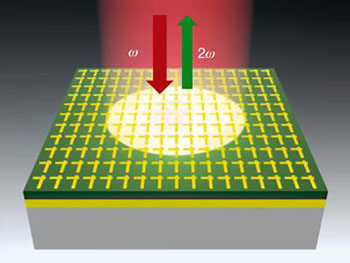
The 400-nanometer-thick nonlinear mirror produces frequency-doubled output through the interaction between the gold plasmonic metasurface and the underlying MQW semiconductor layer. (Source: University of Texas, Austin.)
In recent years, researchers have achieved nonlinear optical responses in semiconductor heterostructures that significantly outstrip the responses in traditional nonlinear materials. But there’s been a catch—the nonlinear response has been limited to incident light polarized perpendicular to the semiconductor layers. Now, a team from the University of Texas, Austin, U.S.A., and the Technische Universität München, Germany, report that they have broken through that restriction. As a result, they've been able to fashion a 400-nm-thick “meta mirror” that can produce nonlinear effects at an intensity roughly a million times better than the best traditional nonlinear materials (Nature, DOI: 10.1038/nature13455).
The researchers achieved the advance by coupling the electromagnetic modes in plasmonic metasurfaces with the control of electronic transitions enabled by multi-quantum-well (MQW) semiconductor heterostructures. The team sandwiched an MQW structure—basically a stack of around 100 nanometer-scale semiconductor layers engineered to optimize the nonlinear response—between a metal ground base and a plasmonic metasurface consisting of asymmetric gold “nanocrosses.” As incident light hits the surface, the MQW semiconductor layers confine electrons into the desired quantum states. The nanocrosses at the surface layer, meanwhile, resonate at input and output frequencies to enable the mirror’s nonlinear optical response. The proof-of-concept system was able to take input light with an intensity as low as that of a laser pointer, and reflect frequency-doubled light at an intensity orders of magnitude greater than in traditional nonlinear materials.
The researchers suggest that these new structures could be tuned to work at frequencies from near-infrared to mid-infrared to terahertz, and can be engineered to produce giant responses for a variety of nonlinear processes beyond frequency doubling. The result, they say, could be a new generation of ultrathin, highly nonlinear optical elements that could help advance laser systems for chemical sensing, explosives detection, biomedical research and other areas with an appetite for compact designs spanning a wide range of wavelengths.
